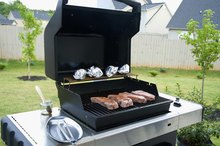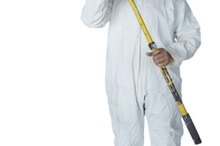The Effects of Carbon Monoxide on the Respiratory System
Carbon monoxide is a colorless, odorless, potentially dangerous gas. It is released in car exhaust, cigarette smoke, the fumes of wood or kerosene burners, and the fumes of faulty central heating systems and gas appliances. Carbon monoxide deprives the body of oxygen, eventually suffocating the victim and causing death. Because it often goes undetected in the home, carbon monoxide poisoning is one of the most common fatal poisonings to occur.
Signs and Symptoms
Since carbon monoxide is odorless, it isn't always apparent when you're inhaling dangerous amounts. Furthermore, the symptoms of carbon monoxide poisoning can be similar to those of other causes and be easily dismissed. Fatigue, headaches and flu-like symptoms are some effects of carbon monoxide poisoning.
In the Lungs
Dangers of Home Oxygen Use
Learn More
When you breathe carbon monoxide, the gas particles are absorbed by the lungs. They then attach themselves to red blood cells in the same way oxygen normally does. The danger is that blood cells bond many time faster to carbon monoxide particles than to oxygen particles, drastically compromising oxygen levels in your body. This can lead to oxygen deprivation, or asphyxiation.
Effects on Breathing
Because carbon monoxide deprives the blood cells of oxygen, the respiratory system struggles to deliver air to the body. This will often appear as shortness of breath, especially during physical activity, though labored breathing can occur even without physical exertion. Sports activities will require more effort and leave you more exhausted than usual. This can worsen over time as your body's ability to obtain oxygen is severely compromised.
Effects on the Lungs
Health Dangers of Gas Grills
Learn More
As carbon monoxide increases in the tissues of your body, your heart is forced to work harder, trying to pump what should be oxygenated blood from the lungs to the rest of your body. This taxes both the heart and the lungs. Your airways will swell and even less air enters the lungs. After long-term exposure, lung tissue is eventually destroyed, leading to lung disease and cardiovascular problems.
Preventing Carbon Monoxide Poisoning
Watch for possible causes of carbon monoxide in your home and work environment. If you have a fireplace, have the chimney checked and cleaned at least once a year. Gas appliances and heating systems should also be checked yearly. If you use a wood burner, make certain the venting is not blocked. Never run motor vehicles in an enclosed garage. Take note if you notice feeling worse (headaches, fatigue, depression, shortness of breath) when you're at home -- particularly during winter when the windows are closed -- but better when you go out. This could indicate dangerous levels of carbon monoxide in your home.
Related Articles
References
- "Toxicology"; Chronic Inhalation of Carbon Monoxide: Effects on the Respiratory and Cardiovascular System at Doses Corresponding to Tobacco Smoking; S. Sørhaug, et al.; December 2006
- National Center For Environmental Research: Effects of Carbon Monoxide on Heart Muscle Cells
- San Lucas Medical: Short-Term Adverse Effects of Carbon Monoxide Pollution on the Respiratory System in Adults: A Systematic Review









